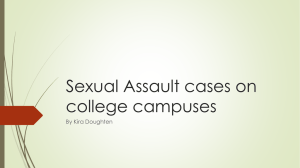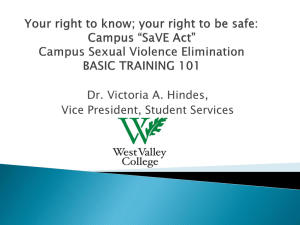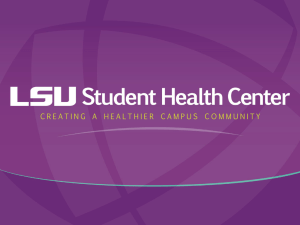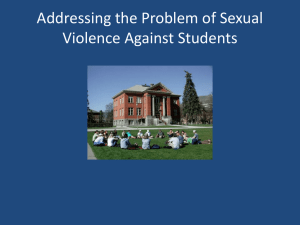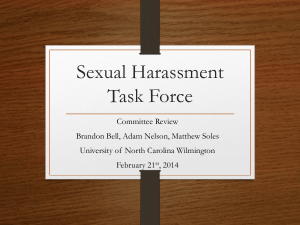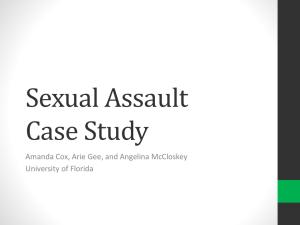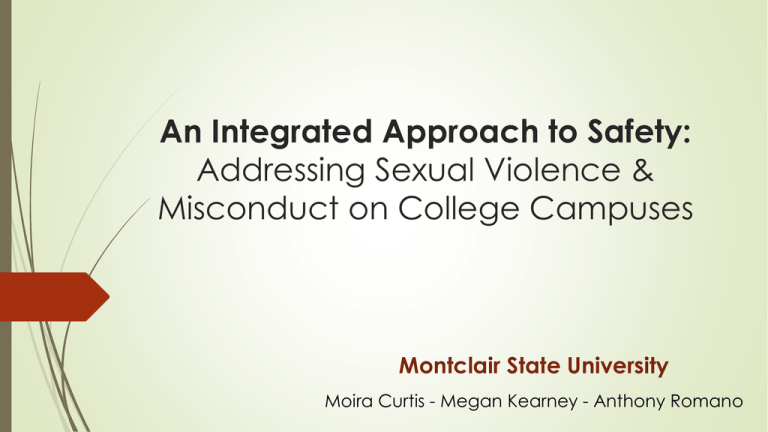
An Integrated Approach to Safety:
Addressing Sexual Violence &
Misconduct on College Campuses
Montclair State University
Moira Curtis - Megan Kearney - Anthony Romano
Presentation Outline
Introduction
Purpose
Approach
Theory
Learning Outcomes
Learning Modules
Technology
Assessment/Conclusion
References
Introduction
In response to the assignment of assuring that sexual violence and sexual
misconduct are prevented and addressed on college campuses, this task force
proposes the following: the implementation of a mandatory curriculum course on
sexual violence.
The following presentation will outline and present our plan to change the
general education curriculum to include an informative and engaging service
learning course.
Purpose
The purpose of building a course into the curriculum that addresses sexual
misconduct is to start cultivating a college community and culture where sexual
violence is not accepted.
An Integrative Approach
While an addition to the general education curriculum is a change within
the Academic Affairs spectrum, the course itself will be co-taught by a
Student Affairs professional and a faculty member.
Depending on the learning module assigned for that week, an on-campus
Student Affairs professional will address current trends, issues, and student
resources available on the subject matter.
Institutionalization Theory
This three-step model addresses institutionalization as a core component for developing
cultural changes in disciplines (in our case, sexual violence culture).
Mobilization
Recognition that change is needed and individuals question the current practices &
policies.
The class and weekly modules will identify sexual violence misconceptions and
issues on the campus.
Implementation
Support for the movement is created, mobilization of faculty and students for a cause.
Faculty in conjunction with Student Affairs leaders will educate and mobilize
students.
Institutionalization
All members accept the alteration of the sexual misconduct values and implement
them as the social norms and values of the institution.
Kezar & Lester (2009)
Project Kaleidoscope: Model for Change
Mobilization
(Plan)
Interdisciplinary
Community:
Reflective
Institutionalization
(Sustain)
Innovative
Integrated
Implementation
(Act)
Projected Learning Outcomes
Multicultural and Transnational Awareness
Critical thinking Skills
Problem Solving Skills
Ethical decision making skills
An understanding of world and national issues
Awareness of issues related to diversity
Policies: Ensuring the rights of those accused of sexual violence are met
Throughout the course students will be educated upon the following
policies:
Violence Against Women Act (VAWA)
Jeanne Clery Act
The Campus SaVE Act
Violence Against Women Act (VAWA): Background
o This is a United States Federal Law of the Violent Crime Control and Law
Enforcement Act of 1994, which was originally signed by President Bill Clinton.
o This act provides $1.6 billion towards investigation and prosecution of violent
crimes against women and imposes automatic and mandatory restitution on
those convicted.
o This act also established the office of Violence Against Women within the
Department of Justice.
o The VAWA was drafted by Senator Joe Biden with support from a broad
coalition of advocacy groups and passed through Congress with bipartisan
support in 1994.
o On March 7, 2013, President Barrack Obama signed the VAWA reauthorization
act of 2013.
The VAWA as a Comprehensive Approach to Violence
Against Women
o Strengthened federal penalties for repeat sex offenders and prevents
offenders from using a victim’s past sexual conduct against them during a
rape trial.
o Mandates that victims are not forced to bear the expense of their rape
exams or for protection order.
o Assists communities in developing dedicated law enforcement and
prosecution units for domestic violence.
o Ensures that police respond to crisis calls and training of law enforcement
officers, prosecutors, victim advocates, and judges.
Jeanne Clery Act and the Campus SaVE Act
o The Campus SaVE Act, enacted in March 2013, is most recent and far
reaching legislation in a long line of laws to protect students from sexual
violence and harassment.
o The SaVE Act applies to all post-secondary institutions that participate in
federal student financial assistance programs under Title IX of the Higher
Education Act of 1965.
o The SaVE Act is an amendment to the Jeanne Clery Act, which was
enacted in 1990 by President George H. W. Bush.
o The Jeanne Clery Act was named after a victim of rape and murder that
occurred at Lehigh University in 1986.
o Each eligible institution must begin to collect the following information in
respect to campus crime statistics and campus security policies.
o Beginning in September 1992, and each year thereafter, institutions must
prepare, publish and distribute to all current students and employees an
annual security report
Overview of the Course
A general education course is the best solution for informing, preventing, and
making a change on the university campus since it is more than a traditional,
one-time student life “program.” The implementation of the general education
course is structured and educational while simultaneously engaging the
community through programming. A course designated to the topic of sexual
misconduct is necessary since it gives students an outlet to discuss a serious
subject matter that they may not feel comfortable addressing in a traditional
student life program. Additionally the course addresses the needs of survivors,
letting them become aware of outlets for assistance on the campus.
The program fits in the General Education curriculum since it expands the
knowledge and comprehension of the student body on a serious societal issue.
Also, it fosters an atmosphere for group work, innovative thinking and the
development of public speaking skills.
A partnership between faculty and the student affairs administration staff is
beneficial to both the student body as well as the university. Working with the
two disciplines intertwined, students will be able to apply what they are learning
in the classroom to campus initiatives and “real world” scenarios, and provides
a breadth of resources beyond the course.
Modules
Module 1:
Defining Key Terms
Module 2:
Myths of Sexual Misconduct
Module 3:
Prevention through Programming Initiatives
Module 4:
Projected Learning Outcomes
Module 5:
Presentation of Learning Outcomes
Module 1: Defining Key Terms
Learning Objective:
To inform students about sexual assault, rape, and consent
Defining terms is difficult because of ambiguity.
Individuals vary in what they consider rape or sexual assault.
Neither rape nor sexual assault have a single clear definition, but vary from
State to State and person to person.
Module 1: Defining Key Terms
Lesson Plan
Students will be taught about key terms such as sexual assault, rape,
rape myths and acceptance and consent.
Students will discuss and share feelings and attitudes regarding these
issues in class and through social media such as Twitter, Blackboard and
Facebook.
Module 1: Defining Key Terms
Sexual Assault
Legal definition: Non-consensual sexual contact and/or intercourse.
Students’ understanding of sexual assault improves after instruction and exposure to
different scenarios.
Sexual assault may also include unwanted fondling, touching, or other sexual acts
that do not involve penetration, but are sexual in nature and are without consent of
victim.
Franciuk (2007)
Rape Myth
Stereotyped or false beliefs about rape, rape victims, and rapists.
Attitudes and beliefs about gender role stereotyping and acceptance of violence
as part of an intimate or dating relationship.
Rape myth acceptance – A construct referring to an individuals level of agreement
with erroneous beliefs about the causes and consequences of sexual assault.
Paul et al. (2009), Garrity (2011)
Module 1: Defining Key Terms
Rape
Legal definition: According the United States Department of Justice (2007) is “an act of
unlawful sexual intercourse with a female, by force or without legal or factual consent.”
Most legal definitions omit male victims and only classify rape if penetration has occurred.
More inclusive definition of rape is the attempted or completed act of oral, anal, or vaginal
intercourse by the use of coercion or force with victims unable or unwilling to give full
consent.
Abbey & McAuslan (2004)
Consent
Most legal scholars agree that the essential characteristic of rape is non-consensual sex
rather than an act of violence.
Typically rape law criminalizes only physically violent sexual attacks, but not the greater
number of sexual assaults which are not violent and occur between people who know each
other.
Failure of Consent
Consent becomes confusing in situations where there is alcohol or drugs.
Consent is also ambiguous in situations where there is a sexual abuse of power, e.g., where a
person in a supervisory position exploits his or her power or where employees or students
acquiesce to sexual demands for fear of economic or professional harm.
Buchhandler-Raphael (2010)
Module 2: Myths of Sexual Misconduct
Learning Objective:
To eliminate the myths about sexual misconduct and teach the
students the facts about sexual misconduct. Some of these topics
include:
Who commits sexual violence? Who are the victims? What are the
accused's rights? When can sexual violence happen? & What
resources are there for survivors?
Students will collaboratively share their thoughts to challenge the
beliefs that they held and replace them with facts.
Module 2: Myths of Sexual Misconduct
This lesson will allow students to:
Use critical thinking skills
Develop an understanding of world and national issues
Develop an awareness of issues related to diversity
Work collaboratively with classmates
Respect other classmates and their opinions
Module 2: Myths of Sexual Misconduct
Lesson Plan:
The student will first be taught about the different facts that surround
sexual misconduct.
Students will then put their recall skills to test when both myths and facts
are presented and they have to decide if each statement is a myth or
a fact.
Technological Component:
http://www.youtube.com/watch?v=N-aLCFq-mnk
Module 3: Prevention through Programming Initiatives
Literature: American College Health Association (ACHA) published Shifting the
Paradigm (2007) which discusses the benefits of programming on college
campuses.
The basis for this module is experiential learning. This is the component where
students will break up into groups and partner with a student affairs office to raise
awareness for sexual misconduct on the campus.
Each group will be expected to actively promote, participate in, or create an
event pertaining to Sexual Misconduct on college campuses related to the
student affairs department they have chosen. After the completion of this,
students will then be expected to present their experience and findings to the
class, as well as host one presentation on campus.
This presentation can be done through outlets such as: resident assistant programs, student
government senate, or presentations to student leaders (student athletic teams, resident assistants,
admissions ambassadors, Greek life leaders).
Module 3: Prevention through Programming Initiatives
Programming Partnership Examples
Counseling and Psychological Services (CAPS)
CAPS Empowerment Ambassador Program
http://www.montclair.edu/counseling-and-psychological-services/
Residential Life
Resident Assistant Programming
Center for Non-Violence & Peace Initiatives
Take Back the Night
http://www.montclair.edu/peace/
Module 3: Prevention through Programming Initiatives
Programming & Service Learning
Benefits:
Brings forth student action.
Creates a common interest within the student body.
Fuels positive energy towards important issues.
Fosters an active community embodying student awareness.
Enables students to recognize and participate in raising social and cultural
consciousness.
Module 4: Projected Learning Outcomes
Learning Objective:
For the students to learn what resources there are on campus for
those sexually abused as well as accused of sexual misconduct.
Learn to reach out to Student Affairs professionals though the
different organizations assigned to each group.
This project will require students to develop and use:
Multicultural and Transnational Awareness
Critical thinking skills
Problem solving skills
Ethical decision making skills
An understanding of world and national issues
Awareness of issues related to diversity
Collaboratively work with their peers and professionals
Module 4: Projected Learning Outcomes
Lesson Plan:
Students will work in their groups and visit the offices on campus that
they were assigned to team up with to develop or work on an existing
event.
Some examples of events would be:
S.A.V.E. (Sexual Assault and Violence Ended)
Take Back the Night
Advertising and assisting with workshops
Module 5: Presentation of Learning Outcomes
Learning Objectives:
To facilitate community experience workshops for target groups,
like student leaders, residential education, athletes, etc. and then
hold an open forum.
Display and educate the community about the offices on
campus and their resources.
Specifically displaying accommodations for survivors by creating
visibility and access to campus facilities and counseling services.
Module 5: Presentation of Learning Outcomes
Lesson Plan:
Co-collaborated Presentations by students and Student Affairs
professionals.
These Student Affairs professionals would be from:
Health Services
CAPS
Women’s Center
Campus Police
Health Promotion
Residential Life Education
Accommodating the unique needs of survivors of sexual violence
Throughout the span of this course if a student is experiencing countertransference from a personal experience, our faculty and staff are
prepared to direct students to services provided by the university. Even
though service accommodations for survivors of sexual violence are being
provided throughout the course, the staff and faculty will be well-versed
with information to address any student concerns that may arise.
A goal of this course is for students to recognize the institutional outlets
available for individuals that have faced sexual violence, as well as prevent
and foster a community which no longer promotes the paradigm of sexual
misconduct on college campuses.
Incorporating Technology into the Sexual Violence Curriculum:
The Objective
o To utilize social media networking tools, such as Twitter, to present ideas and
create dialogue between faculty, students, and community within and
outside the classroom.
Uses of Technology in the Classroom
o Within the class Twitter can be used for instant feedback
between teachers and students.
o Micro blogging and Twitter encourages careful listening,
gathering information, and multitasking.
o Encourages student participation, especially in large classes.
o Outside the classroom, Twitter can be used to extend class
conversations between students and allows for greater
openness.
Tyma (2011)
Advantages of using Social Media in the Class
o Allows for instant peer to peer communication and greater
understanding of class topics about sexual violence.
o Supports informal learning.
o Facilitates the sharing of ideas within the class.
o Additional way for students to have a voice and express
themselves where they might feel awkward to speak out in
class.
o By monitoring the Twitter feed, the instructor will incorporate
these ideas into the overall classroom discussion.
Kassens-Noor (2012)
Disadvantages of using Social Media in the Class
o Constraining critical thinking and self-reflection because of
Twitter’s character limit.
o Instructors intending to foster critical, in-depth, and selfreflective thinking may find Twitter unsuitable for their
purposes.
Kassens-Noor (2012)
Blackboard Online Learning Management System
o This will be utilized in the class for posting additional readings
related to sexual violence.
o Additionally, Blackboard will be used to provide information
regarding the laws that deal with rape and sexual violence
such as the Clery Act and the Violence Against Women Act
(VAWA).
o Blogs will be used in the same way Twitter is used, but without
the constraint of 140 characters.
Facebook
o Class will have a Facebook page, designed not only for the
students enrolled in the class, but to hopefully engage the
entire campus community, thus educating the masses
regarding the prevention and the interventions of sexual
violence and assault.
o Events created by the class that are geared towards
prevention of sexual violence and interventions for victims of
sexual violence will be advertised for the college community.
Assessing Success of Curriculum
Survey students at the completion of the course
Students will evaluate the course instruction
Conduct focus groups to determine attitude change regarding
perceptions of sexual abuse and its victims.
Thank you for granting us this unique opportunity.
References
Abbey, A., & McAuslan, P. (2004). A longitudinal examination of male college
students’ perpetration of sexual assault. Journal of Consulting and Clinical Psychology,
72, 747-756. doi: 10.1037/0022-006X.72.5.747
Buchhandler-Raphael, M. (2010). The failure of consent: Re-conceptualizing rape as
sexual abuse of power. Michigan Journal of Gender and Law, 18, (1), Available at
SSRN:http://ssrn.com/abstract=1671545
Franiuk, R. (2007). Discussing and defining sexual assault: A classroom activity. College
Teaching,
55, (3), 104-107. doi: 10.3200/CTCH.55.3.104-108
Garrity, S. E. (2011). Sexual assault prevention programs for college-aged men: A
critical evaluation. Journal of Forensic Nursing, 7, 40-48. doi: 10.111/j.19393938.2010.01094.x
Kassens-Noor, E. (2012). Twitter as a teaching practice to enhance active and informal
learning in higher education: The case of sustainable tweets. Active Learning in Higher
Education, 13, (1), 9-21. doi: 10.1177/1469787411429190
Kezar, A., & Elrod, S. (2012). Facilitating Interdisciplinary Learning: Lessons from Project
Kaleidoscope. Change: The Magazine Of Higher Learning, 44(1), 16-25.
Kezar, A., & Lester, J. (2009). Organizing higher education for collaboration. San
Francisco, CA: Jossey-Bass.
References Continued…
Myths and facts. Retrieved from http://sarcoregon.org/myths-and-facts/
(2014). Myths & facts. Retrieved from http://connsacs.org/learn/index.htm
Paul, L. et al. (2009). Perceptions of peer rape myth acceptance and
disclosure in a sample of college sexual assault survivors. Psychological
Trauma: Theory, Research, Practice, and Policy, 1, (3), 231-241. doi:
10.1037/a0016989
Tyma, A. (2011). Connecting with what is out there!: Using twitter in the
large lecture. Communication
Teacher, 25, (3), 175-181. doi:
10.1080/17404622.2011.579911
Violence Against Women Act. (2013). Retrietved from
http://www.whitehouse.gov/sites/default/files/docs/vawa_factsheet.pdf


